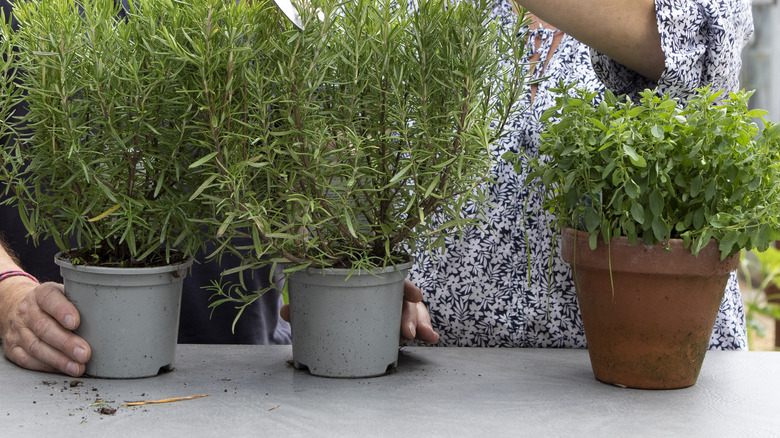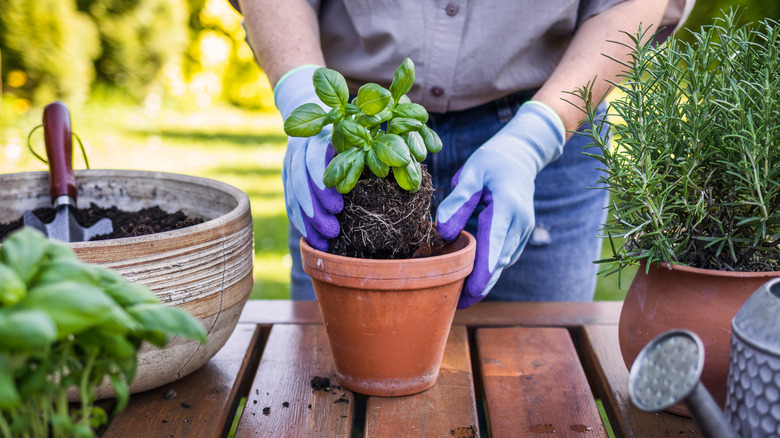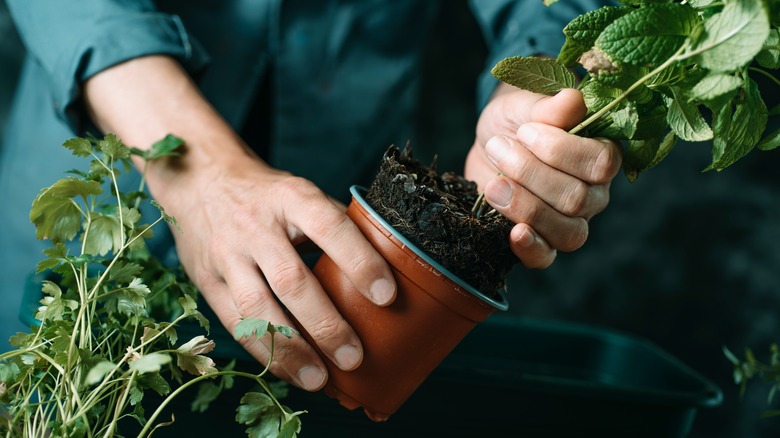Is It Better To Grow Herbs In Plastic Or Terracotta Pots?
If you love to cook or drink herbal tea, growing an herb garden can be a fun and rewarding experience. Growing herbs in pots is a way for keen gardeners who don't have a lot of outdoor space to grow plants indoors, or on a balcony or patio. For those of you who have a good-sized garden, growing herbs in pots instead of in the ground will stop them from taking over and driving your other plants out, like mint is prone to do. If you've decided to plant your herbs in pots, you may wonder if it's better to grow herbs in plastic or terracotta pots. Well, there are pros and cons to both plastic and terracotta pots when it comes to growing herbs.
Whether you decide to go for plastic or terracotta pots may depend on how you're using them. If you want to bury pots in the ground to divide invasive herbs and stop them from taking over the whole garden, for example, a large plastic bucket with the bottom cut out works well when buried underground – being less likely to crack and allow roots to escape through the dividing wall. Terracotta pots are heavier and more attractive and may be better suited to creating a pretty herb garden on your windowsill, where they are less likely to be blown over, especially if you choose a long planter. Let's take a closer look at the pros and cons of plastic versus terracotta pots in more detail.
The pros and cons of planting herbs in terracotta pots
Not only are terracotta pots more attractive, they have a number of benefits over plastic pots. Terracotta is made from clay and water fired in an oven. It is highly porous, allowing air to penetrate through the wall of the pot and circulate in the soil to help avoid disease. This, along with the fact that the terracotta also wicks moisture out from the soil, enabling it to evaporate more easily, means that plants are less likely to suffer from root rot, Because terracotta is a natural material it is better for the environment than plastic. These pots are also heavier, which makes them less likely to blow over your balcony or fall off a window sill.
There are downsides to planting your herbs in terracotta pots though. They're more expensive — unless you also purchase outer decorative glazed ceramic planters to put your plastic pots in. Terracotta is also more prone to cracking and chipping, especially if you use them outdoors in cold weather. Another thing to consider is that terracotta is heavy to bring indoors over the winter. These pots also develop a distinctive patina over time that not everyone loves; this is caused by salt and mineral residue building up on the surfaces of the pot as it draws water through, along with exposure to the elements. Disinfecting terracotta pots, which may be necessary in the case of disease, is much harder than cleaning plastic as the material is so porous and more likely to hold pathogens.
The pros and cons of planting herbs in plastic pots
Plastic pots are extremely convenient: You can purchase them in low-cost value packs, and they are lightweight yet durable. This is because they don't absorb water, which is what attracts the growth of fungi and rot. They also come in a variety of colors, from mock terracotta to green, black, and more daring colors too. Plus, it's easier to swap decorative outer pots to suit your home decor if you grow your herbs indoors. Plastic is a better option for people who tend to forget about their plants, because these pots retain moisture, meaning your plants won't dry out quickly.
There are some cons to consider when using plastic pots to grow herbs in, though. You do have to be more careful about over-watering, as this can easily lead to root rot. Plastic plant pots are not very breathable either, and they trap heat from the sun, creating a damaging environment for delicate root systems. To avoid these issues, try not to position plastic pots in full sun, and make sure to use well-draining soil that allows for good air circulation, with plenty of drainage holes for excess water to escape – you can make more holes if you need to using a drill, screwdriver, or even just a large nail and hammer.


